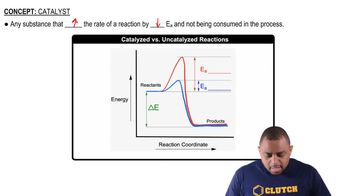Here are the essential concepts you must grasp in order to answer the question correctly.
Balancing Chemical Equations
Balancing chemical equations is essential to ensure that the law of conservation of mass is upheld, meaning that the number of atoms of each element must be the same on both sides of the equation. This involves adjusting coefficients in front of the chemical formulas to achieve balance. For example, in the reaction of ethane (C2H6) with water (H2O), one must determine the correct stoichiometric coefficients to balance the products formed.
Recommended video:
Balancing Chemical Equations
Catalysts in Reactions
A catalyst is a substance that increases the rate of a chemical reaction without being consumed in the process. In the given reaction, a catalyst is indicated, which suggests that the reaction may proceed more efficiently or at a lower temperature. Understanding the role of catalysts is crucial for predicting the behavior of reactions and optimizing conditions for desired outcomes.
Recommended video:
Catalyzed vs. Uncatalyzed Reactions
Thermochemistry and Heat in Reactions
Thermochemistry studies the heat changes associated with chemical reactions. The notation 'heat' in the reaction indicates that the process is endothermic or exothermic, depending on whether heat is absorbed or released. Recognizing how heat influences reaction dynamics helps in understanding reaction mechanisms and the energy profiles of reactants and products.
Recommended video:
 Verified step by step guidance
Verified step by step guidance


